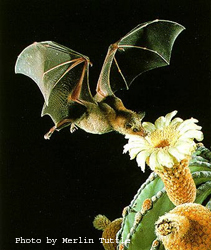Animal Fact Sheet: Lesser Long-nosed Bat

Identifying Features
Adult lesser long-nosed bats are yellow-brown to gray above, with rusty brown fur on their belly. Their tails are short and their ears are small. Like all members of the leaf-nosed bat family, they have a triangular shaped noseleaf that juts from the end of their noses.
Adaptations
These bats are nocturnal in order to feed from the plants like saguaro cactus whose flowers open at night. The flowers are light in color which make them easy for the bats to see. They also produce a strong odor which the bats can smell in the night air. These bats have a long slender face as well as a long tongue which enables then to better reach inside the flower for the sweet nectar.
Habitat
Lesser long-nose bats are found in desert scrub habitat.
Range
They are found in southern Arizona and southwestern New Mexico, western Mexico, Baja California del Sur and into Central America.
Wild Status
In 1988 these bats were listed as endangered by the U.S. Fish and Wildlife service. Maternity roost disturbance and effects of habitat loss are the primary threats for these bats.
Diet
They feed exclusively on the fruit and nectar of night-blooming cacti including saguaro and organ pipe, as well as many species of agave.
Predators
Predators such as owls, snakes and bobcats will wait at cave entrances or interiors looking for individuals who have fallen to the ground or those that they can catch in flight.
Home
Thousands of these bats will spend their day roosting in caves or mines. Caves and mines offer general safety from predators, provide the proper temperature, are used as maternity sites, and places to rest during migration.
Life Span
Lesser long-nosed bats live approximately 20 years.
Size
These bats are small weighing only 0.4 to 0.7 ounces (1.2 to 20 gm). They are 2.5 to 3 inches long with a 14 inch wingspan.
Quick Facts
-
This bat can reach flight speeds up to 14 miles per hour.
-
Bats are the only mammals that can fly.
-
Bats are among the most threatened land mammals in North America, with over half the species either listed as threatened or endangered or candidates to become listed as such.
Comparison
Compare with the Little Red Flying Fox of the Australian Desert.
 ©Copyright 2008, Arizona-Sonora Desert Museum
©Copyright 2008, Arizona-Sonora Desert Museum